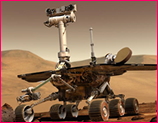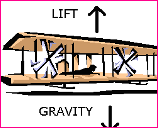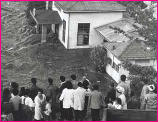Posted on April 24th, 2011 by Mary Lord
 In this lesson, teams of students in grades 3-5 will use their knowledge of tornadoes and damage to design a structure that will withstand wind and protect people from twisters. Each group will create a poster with the name of their engineering firm and a picture of their structure, then present their design to the class.
In this lesson, teams of students in grades 3-5 will use their knowledge of tornadoes and damage to design a structure that will withstand wind and protect people from twisters. Each group will create a poster with the name of their engineering firm and a picture of their structure, then present their design to the class.
Read More
Filed under: Class Activities, Grades K-5, Grades K-5, Lesson Plans | Comments Off on Lesson: Design a Tornado-Proof Building
Tags: Class Activities, Disaster, Disaster relief, Grades K-5, Lesson Plan, Lesson Plans
Posted on April 17th, 2011 by ASEE
 In this lesson, students in grades 6-12 learn how to make a graph to measure average velocity and calculate the mid-times for personal intervals of student runs, walks, and jogs. Working in groups, one member walks, jogs, or runs in a straight-line path while attempting to maintain a constant velocity. The other group members time the runner along the path, and then record and graph the data of each run.
In this lesson, students in grades 6-12 learn how to make a graph to measure average velocity and calculate the mid-times for personal intervals of student runs, walks, and jogs. Working in groups, one member walks, jogs, or runs in a straight-line path while attempting to maintain a constant velocity. The other group members time the runner along the path, and then record and graph the data of each run.
Read More
Filed under: Grades 6-8, Grades 9-12, Lesson Plans | Comments Off on Lesson: Measuring Velocity
Tags: Class Activities, Grades 6-12, Lesson Plan, Mathematics
Posted on April 3rd, 2011 by Mary Lord
 In this activity, students will explore how sensing is part of robotics by tying their shoes with different constraints. After lacing their shoes normally, try it wearing thick gloves or with popsicle sticks taped to fingers so they can’t bend. Can students tie their shoes now? A connection is made to the limitations of the motion of robots, and to the role of design in allowing robots to perform different functions.
In this activity, students will explore how sensing is part of robotics by tying their shoes with different constraints. After lacing their shoes normally, try it wearing thick gloves or with popsicle sticks taped to fingers so they can’t bend. Can students tie their shoes now? A connection is made to the limitations of the motion of robots, and to the role of design in allowing robots to perform different functions.
Read More
Filed under: Grades 6-8, Grades 9-12, Grades K-5, Lesson Plans | Comments Off on 1, 2, Robot Hands Please Tie My Shoe
Tags: Class Activities, Lesson Plan, Museums, Robotics, Science
Posted on April 3rd, 2011 by Mary Lord
 In this activity, students will learn the challenges of operating a robotic rover on the distant Red Planet and solve problems through a hands-on simulation. After trying to navigate an obstacle course blindfolded and guided only by verbal commands, students will discover that tooling around Mars is no simple joy-stick ride.
In this activity, students will learn the challenges of operating a robotic rover on the distant Red Planet and solve problems through a hands-on simulation. After trying to navigate an obstacle course blindfolded and guided only by verbal commands, students will discover that tooling around Mars is no simple joy-stick ride.
Read More
Filed under: Grades 6-8, Grades K-5, Lesson Plans | Comments Off on Mars Rover Races
Tags: Class Activities, Lesson Plan, Lesson Plans, NASA, Robotics
Posted on March 27th, 2011 by ASEE
 In this lesson, you’ll introduce your students to the four forces of flight–drag, lift, thrust, and weight–through a variety of fun-filled flight experiments. Students will “fly” for short periods and then evaluate factors that might either increase or decrease their “flight” duration.
In this lesson, you’ll introduce your students to the four forces of flight–drag, lift, thrust, and weight–through a variety of fun-filled flight experiments. Students will “fly” for short periods and then evaluate factors that might either increase or decrease their “flight” duration.
Read More
Filed under: Class Activities, Grades 6-8, Grades 6-8, Grades K-5, Grades K-5, Lesson Plans | 1 Comment »
Tags: Aerodynamics, Aeronautics, Class Activities, Lesson Plan, Physics
Posted on March 27th, 2011 by Mary Lord
 It’s easy to find your way to school. Now imagine trying to navigate the skies, with no signs to point you in the right direction. How do pilots find their way? These “pilot training lessons” developed by the Center for Innovation in Engineering and Science Education at the Stevens Institute of Technology will teach your young aviators the principles of navigation in a fun series of real-time activities.
It’s easy to find your way to school. Now imagine trying to navigate the skies, with no signs to point you in the right direction. How do pilots find their way? These “pilot training lessons” developed by the Center for Innovation in Engineering and Science Education at the Stevens Institute of Technology will teach your young aviators the principles of navigation in a fun series of real-time activities.
Read More
Filed under: Class Activities, Grades 6-8, Grades 6-8, Grades 9-12, Grades K-5, Lesson Plans, Web Resources | 2 Comments »
Tags: Aeronautics, Aerospace, airplane, Class Activities, flight, Grades 6-8, Lesson Plan, Mathematics, NASA, Physics, vectors, windspeed
Posted on March 25th, 2011 by Mary Lord
 In this lesson, you’ll introduce your students to the four forces of flight — drag, lift, thrust, and weight — through a variety of fun flight experiments. Students will “fly” for short periods and then evaluate factors that might either increase or decrease their “flight” duration. They also will discover how air moving at different speeds over a wing keeps planes aloft.
In this lesson, you’ll introduce your students to the four forces of flight — drag, lift, thrust, and weight — through a variety of fun flight experiments. Students will “fly” for short periods and then evaluate factors that might either increase or decrease their “flight” duration. They also will discover how air moving at different speeds over a wing keeps planes aloft.
Read More
Filed under: Grades 6-8, Grades 9-12, Lesson Plans | 1 Comment »
Tags: Aerodynamics, Aeronautics, Aerospace, Lesson Plan, Lesson Plans
Posted on March 20th, 2011 by Mary Lord
 Basketball not only is fun to play or watch–it packs a lot of math and science in each move. In this lesson, developed by NPR’s Talking Science with John Fontanella, a physicist at the U.S. Naval Academy and author of The Physics of Basketball, students will learn how physics affects the game. What forces are acting on the ball? What must players do to offset these forces?
Basketball not only is fun to play or watch–it packs a lot of math and science in each move. In this lesson, developed by NPR’s Talking Science with John Fontanella, a physicist at the U.S. Naval Academy and author of The Physics of Basketball, students will learn how physics affects the game. What forces are acting on the ball? What must players do to offset these forces?
Read More
Filed under: Class Activities, Grades 6-8, Grades 6-8, Lesson Plans | Comments Off on Lesson: Free Shot Physics
Tags: Class Activities, Grades 6-8, Lesson Plan, Lesson Plans, Physics
Posted on March 13th, 2011 by Mary Lord
 From buildings that sway rather than collapse to tsunami seawalls and drills, Japan’s earthquake precautions have made the nation uniquely prepared for disaster. Learn how Japanese construct skyscrapers and other earthquake-resistant engineering in this New York Times feature. Such practices undoubtedly helped save lives, though the toll from last week’s temblor and giant wave continues to mount.
From buildings that sway rather than collapse to tsunami seawalls and drills, Japan’s earthquake precautions have made the nation uniquely prepared for disaster. Learn how Japanese construct skyscrapers and other earthquake-resistant engineering in this New York Times feature. Such practices undoubtedly helped save lives, though the toll from last week’s temblor and giant wave continues to mount.
Read More
Filed under: Class Activities, Grades 6-8, Grades 9-12, Lesson Plans, Special Features | Comments Off on Feature: Engineered for Earthquakes
Tags: Curriculum, Environmental Engineering, Japan, Lesson Plan, Physics
 In this lesson, teams of students in grades 3-5 will use their knowledge of tornadoes and damage to design a structure that will withstand wind and protect people from twisters. Each group will create a poster with the name of their engineering firm and a picture of their structure, then present their design to the class.
In this lesson, teams of students in grades 3-5 will use their knowledge of tornadoes and damage to design a structure that will withstand wind and protect people from twisters. Each group will create a poster with the name of their engineering firm and a picture of their structure, then present their design to the class.








 In this lesson, students in grades 6-12 learn how to make a graph to measure average velocity and calculate the mid-times for personal intervals of student runs, walks, and jogs. Working in groups, one member walks, jogs, or runs in a straight-line path while attempting to maintain a constant velocity. The other group members time the runner along the path, and then record and graph the data of each run.
In this lesson, students in grades 6-12 learn how to make a graph to measure average velocity and calculate the mid-times for personal intervals of student runs, walks, and jogs. Working in groups, one member walks, jogs, or runs in a straight-line path while attempting to maintain a constant velocity. The other group members time the runner along the path, and then record and graph the data of each run. In this activity, students will explore how sensing is part of robotics by tying their shoes with different constraints. After lacing their shoes normally, try it wearing thick gloves or with popsicle sticks taped to fingers so they can’t bend. Can students tie their shoes now? A connection is made to the limitations of the motion of robots, and to the role of design in allowing robots to perform different functions.
In this activity, students will explore how sensing is part of robotics by tying their shoes with different constraints. After lacing their shoes normally, try it wearing thick gloves or with popsicle sticks taped to fingers so they can’t bend. Can students tie their shoes now? A connection is made to the limitations of the motion of robots, and to the role of design in allowing robots to perform different functions. In this activity, students will learn the challenges of operating a robotic rover on the distant Red Planet and solve problems through a hands-on simulation. After trying to navigate an obstacle course blindfolded and guided only by verbal commands, students will discover that tooling around Mars is no simple joy-stick ride.
In this activity, students will learn the challenges of operating a robotic rover on the distant Red Planet and solve problems through a hands-on simulation. After trying to navigate an obstacle course blindfolded and guided only by verbal commands, students will discover that tooling around Mars is no simple joy-stick ride.  In this lesson, you’ll introduce your students to the four forces of flight–drag, lift, thrust, and weight–through a variety of fun-filled flight experiments. Students will “fly” for short periods and then evaluate factors that might either increase or decrease their “flight” duration.
In this lesson, you’ll introduce your students to the four forces of flight–drag, lift, thrust, and weight–through a variety of fun-filled flight experiments. Students will “fly” for short periods and then evaluate factors that might either increase or decrease their “flight” duration. It’s easy to find your way to school. Now imagine trying to navigate the skies, with no signs to point you in the right direction. How do pilots find their way? These “pilot training lessons” developed by the Center for Innovation in Engineering and Science Education at the Stevens Institute of Technology will teach your young aviators the principles of navigation in a fun series of real-time activities.
It’s easy to find your way to school. Now imagine trying to navigate the skies, with no signs to point you in the right direction. How do pilots find their way? These “pilot training lessons” developed by the Center for Innovation in Engineering and Science Education at the Stevens Institute of Technology will teach your young aviators the principles of navigation in a fun series of real-time activities. In this lesson, you’ll introduce your students to the four forces of flight — drag, lift, thrust, and weight — through a variety of fun flight experiments. Students will “fly” for short periods and then evaluate factors that might either increase or decrease their “flight” duration. They also will discover how air moving at different speeds over a wing keeps planes aloft.
In this lesson, you’ll introduce your students to the four forces of flight — drag, lift, thrust, and weight — through a variety of fun flight experiments. Students will “fly” for short periods and then evaluate factors that might either increase or decrease their “flight” duration. They also will discover how air moving at different speeds over a wing keeps planes aloft. Basketball not only is fun to play or watch–it packs a lot of math and science in each move. In this lesson, developed by NPR’s Talking Science with John Fontanella, a physicist at the U.S. Naval Academy and author of The Physics of Basketball, students will learn how physics affects the game. What forces are acting on the ball? What must players do to offset these forces?
Basketball not only is fun to play or watch–it packs a lot of math and science in each move. In this lesson, developed by NPR’s Talking Science with John Fontanella, a physicist at the U.S. Naval Academy and author of The Physics of Basketball, students will learn how physics affects the game. What forces are acting on the ball? What must players do to offset these forces?  From buildings that sway rather than collapse to tsunami seawalls and drills, Japan’s earthquake precautions have made the nation uniquely prepared for disaster. Learn how Japanese construct skyscrapers and other earthquake-resistant engineering in this New York Times feature. Such practices undoubtedly helped save lives, though the toll from last week’s temblor and giant wave continues to mount.
From buildings that sway rather than collapse to tsunami seawalls and drills, Japan’s earthquake precautions have made the nation uniquely prepared for disaster. Learn how Japanese construct skyscrapers and other earthquake-resistant engineering in this New York Times feature. Such practices undoubtedly helped save lives, though the toll from last week’s temblor and giant wave continues to mount.